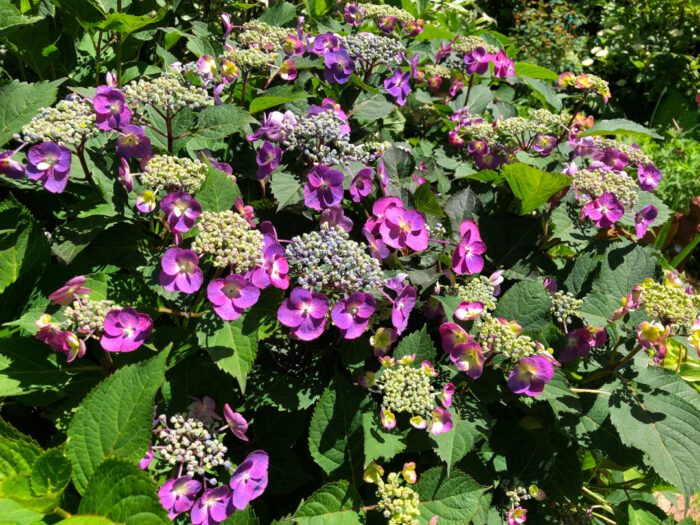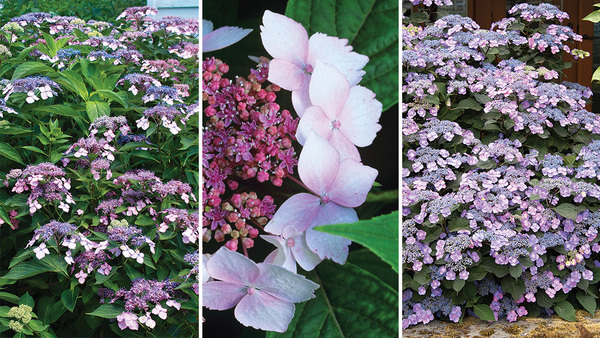
Today we’re going back to June with Carla Zambelli Mudry, looking at some photos from hydrangea season in her garden in Malvern, Pennsylvania.
I have a deep love for hydrangeas. I rediscovered them as an adult visiting the Hamptons in New York. They are an integral part of the summer landscape up there and are very tough and indestructible plants. I love the diversity of hydrangeas available. Among my favorites are those with airy fairy lacecap flowers.
I think every garden should have hydrangeas, just like I think every garden should have roses.
 This lacecap hydrangea is in full bloom (Hydrangea macrophylla or H. serrata, Zones 5–9). “Lacecap” is a term used to describe hydrangeas that have a ring of large, showy, sterile flowers around the outside of the bloom, and a cluster of smaller, fertile ones in the middle. This is the normal form for these plants in the wild, with the large, sterile flowers serving to draw pollinators in to the fertile blooms in the middle.
This lacecap hydrangea is in full bloom (Hydrangea macrophylla or H. serrata, Zones 5–9). “Lacecap” is a term used to describe hydrangeas that have a ring of large, showy, sterile flowers around the outside of the bloom, and a cluster of smaller, fertile ones in the middle. This is the normal form for these plants in the wild, with the large, sterile flowers serving to draw pollinators in to the fertile blooms in the middle.
 This lovely lacecap hydrangea is a rich shade of purple. The color of hydrangea blooms is a combination of the soil and the genetics of the individual variety. The hydrangea plant needs aluminum to produce the blue pigment. In acidic soils, aluminum is very available and is easily taken up into the plant to make rich blue colors. In more alkaline soils, aluminum is chemically bound to the soil and the plants can’t absorb it, so the flowers stay pink.
This lovely lacecap hydrangea is a rich shade of purple. The color of hydrangea blooms is a combination of the soil and the genetics of the individual variety. The hydrangea plant needs aluminum to produce the blue pigment. In acidic soils, aluminum is very available and is easily taken up into the plant to make rich blue colors. In more alkaline soils, aluminum is chemically bound to the soil and the plants can’t absorb it, so the flowers stay pink.
 A beautiful pink lacecap form, delicate and graceful
A beautiful pink lacecap form, delicate and graceful
 Mophead varieties produce mostly large sterile flowers instead of just an outer ring like in the lacecap types. This means they can produce few if any seeds, but they really make an over-the-top display in the garden.
Mophead varieties produce mostly large sterile flowers instead of just an outer ring like in the lacecap types. This means they can produce few if any seeds, but they really make an over-the-top display in the garden.
 Think you don’t have room for a hydrangea? Many of the newer varieties are quite compact and will thrive in a container. Just give them a little extra protection from winter cold by moving them into a shed or garage if you live in a cold climate.
Think you don’t have room for a hydrangea? Many of the newer varieties are quite compact and will thrive in a container. Just give them a little extra protection from winter cold by moving them into a shed or garage if you live in a cold climate.
 While the classic mophead and lacecap hydrangeas are native to Asia, the smooth hydrangea (Hydrangea arborescens, Zones 3–9) is native to the southeastern United States. Much more cold hardy than their Asian relatives, they’re easy to grow in nearly every garden and make big heads of white flowers.
While the classic mophead and lacecap hydrangeas are native to Asia, the smooth hydrangea (Hydrangea arborescens, Zones 3–9) is native to the southeastern United States. Much more cold hardy than their Asian relatives, they’re easy to grow in nearly every garden and make big heads of white flowers.
 Smooth hydrangeas generally have white flowers, but new breeding has produced pink forms, a wonderful addition to this fantastic plant.
Smooth hydrangeas generally have white flowers, but new breeding has produced pink forms, a wonderful addition to this fantastic plant.
Another great species of hydrangea native to the southeastern United States is the oakleaf hydrangea (Hydrangea quercifolia, Zones 5–9), with big, conical flower heads and beautifully bold foliage.
Have a garden you’d like to share?
Have photos to share? We’d love to see your garden, a particular collection of plants you love, or a wonderful garden you had the chance to visit!
To submit, send 5-10 photos to [email protected] along with some information about the plants in the pictures and where you took the photos. We’d love to hear where you are located, how long you’ve been gardening, successes you are proud of, failures you learned from, hopes for the future, favorite plants, or funny stories from your garden.
Have a mobile phone? Tag your photos on Facebook, Instagram or Twitter with #FineGardening!
Do you receive the GPOD by email yet? Sign up here.


















Comments
Seeing your summer photos of your Hydrangeas was so refreshing!
Love that lavender lacecap!
Log in or create an account to post a comment.
Sign up Log in